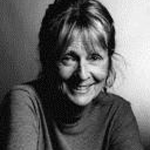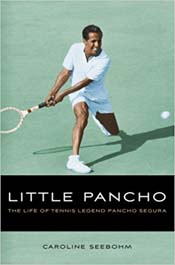The Three Greatest Years
Caroline Seebohm

By the middle of 1949, Bobby Riggs was burned out. Having been beaten by Kramer an embarrassing number of times at the end of the 1948 North American Tour, Riggs had pulled himself together enough to win the U.S. Professional Championships at Forest Hills against Don Budge.
But his best playing days were over, and his fans were losing interest. Jack Kramer's star was in the ascendancy, and the tour had only served to enhance the younger man's image, while Riggs admitted that he was depressed and exhausted.
So Bobby Riggs, never one to flinch before a big gamble, retired his tennis racket at the age of thirty-one. But he wasn't finished with tennis by any means. With Jack Harris out of the picture, he saw a chance to stay in the game as a promoter.
Working with Jack Kramer as his prime draw and business partner, maybe they'd make some money. But without Riggs on the marquee, they needed new blood from the amateur ranks to replace him, and there seemed only two possibilities--Ted Schroeder and Richard Gonzales.
Schroeder, Jack Kramer's friend and doubles partner, had been ranked among the top ten in the United States and world for many years, as well as having won the doubles title several times at Forest Hills. He was known for his courage and stamina and was a stalwart presence during many years of Davis Cup play.

Gonzales was another matter altogether. Only twenty-one in 1949, he had exploded on the scene in a major way by winning the U.S.Championship and clay court titles in 1948. Yet in a series of practice matches against Don Budge in Los Angeles, he only won one set out of twenty-five matches. He also had a poor record against Schroeder. Moreover, his background and reputation made him a risky bet under any circumstances.
A few weeks before Wimbledon in the summer of 1949, Riggs and Kramer met Schroeder in London to make a deal. Schroeder agreed to turn pro for a fee of twenty-five thousand dollars, regardless of the gate.
Two weeks later Schroeder called off the deal. Riggs and Kramer were furious, but they could not dissuade him. They were faced with the only possible alternative.
Gonzales had just lost in a badly played fourth-round match at Wimbledon. Bobby Riggs wasted no time in finding out which plane Gonzales was flying back home to Los Angeles, and he wrangled his way on to the seat next to him. For most of the six-hour flight, Riggs worked his charm and powers of persuasion to induce Gonzales to turn pro.
It must have been quite a scene, the small, button-faced tennis champion-promoter with the high-pitched voice talking up a deal to the tall, swarthy outrider from West Central L.A., as the plane flew over the Rockies. The two men had common ground however, apart from tennis: both were inveterate gamblers.
Never in his life had Richard Gonzales been offered the gamble that Riggs presented to him now--a contract to play tennis against the number one in the world, Jack Kramer. Of course he could not turn it down.
The new tour opened on October 25, 1949 at Madison Square Garden to a huge and enthusiastic crowd. Once again Dinny Pails and Segura, without such attractive financial enticements, were lined up as the animal act.

The first match prefigured the disaster to follow. Kramer beat Gonzales 6-4, 3-6, 6-3, 6-2. Of their twenty-six ensuing matches held throughout North America, Kramer won twenty-two, including Gonzales's most humiliating defeat in Waterloo, Ontario, of 6-1, 6-1.
Gonzales was young and untested. He didn’t understand the grinding schedule he would have to endure. He hated to lose those endless matches, night after night. His competitive spirit was bruised. The consistent losses eroded his confidence and turned his enjoyment in the game into anger and disappointment.
Deep Trouble
With the collapse of Gonzales, Bobby Riggs's tour was in deep trouble. No other amateur player was ready to turn pro and take on Jack Kramer. With Bobby out of the game, the cupboard was bare. Kramer wondered if they should start publicizing Pancho Segura, their most popular player, who had become very competitive in the most recent year.
On New Year's Day of 1950, Segura beat Kramer handily in Paris with the score of 6-3, 6-2. He beat Kramer again in June in 5 sets in the semifinals of the U.S. Pro Indoor.
But as entertaining as Segura could be, he wouldn’t do the tour much good coming into a town, because he didn’t come in with any amateur publicity--no Forest Hills or Wimbledon titles, no Davis Cup play. Segura had turned pro before he could contend seriously for those titles.

So Riggs and Kramer came up with a desperate solution. Bring in a woman. The obvious woman on the tennis circuit was Gertrude (Gussie) Moran. Lots of people had heard of Gussie Moran. She came from California and was ranked number four in the country.
But more to the point in marketing terms, she was long-legged, pretty, and thanks to a provocative appearance at Wimbledon wearing lacy panties, had been dubbed "Gorgeous Gussie" by the British tabloids.
Pauline Dominates
Riggs and Kramer decided to pit her against Pauline Betz, not as well known, but a far better tennis player. Betz was 1946 Wimbledon singles champion and four time national champion at Forest Hills.
The two ladies would appear first, and then Kramer would go up against Segura. For the first time, Segura had a stake in the tour--one thousand dollars a week plus 5 percent of the gate.
Kramer took a smaller cut than usual--only 25 percent of the gate--in order to get Gussie Moran. Bobby as promoter had the best deal--40 percent. Pauline Betz was paid a straight fee.
But the opening match, at Madison Square Garden on October 28, 1950, was yet another disaster. Gorgeous Gussie, expected to deliver the sexpot image the audiences had been promised, appeared in very low key, conventional tennis clothes, while Pauline startled the fans by showing up in silver lame shorts and a bright pink sweater.

Having annihilated Gussie in the fashion department, Pauline went on to annihilate her on the tennis court, 6-0, 6-3, in just over half an hour. The male performers did little better in competitive terms--Kramer easily beat Segura.
At this all important opener, there was no excitement, no tension. Moreover, in spite of all the publicity Riggs generated, the gate was surprisingly small-only 6,526 people showed up.
As Kramer said later, "Tennis fans come to see tennis." Lacking competitive championship play to present to audiences, Riggs's publicity did not pay off.
The badly matched foursome traveled on to other cities, but the scores were the same, even after Kramer begged Pauline to try and make her matches with Gussie a little more competitive. After a while it was decided that the women should only play one set, but it made no difference. The fans stayed away in droves.
With no advance ticket money, the tour ended up just about bankrupt. It closed in March having grossed just over ninety-four thousand dollars, not even a third of the figure collected during the Riggs and Kramer tour.
Only Tennis
As for Segura, the Gussie Moran experiment was merely a distraction. All he cared about was tennis. "We were pioneers of the game," he said. "I wanted to play tennis, that's all. I would think about it all the time, eat, sleep, dream tennis."
The women idea wasn't working, but much more important to Segura was his promotion to playing the main event with Kramer. These matches were the critical test of Pancho's game, and he knew it.

Every match became a question of slaying the dragon, and every loss haunted him forever afterward. "I lost a match to him in Santa Barbara. I had him 5-0, 5-1. I couldn't sleep that night.
"Jack was a tough competitor. He wanted to destroy you. He was a killer."
"In London I had him 4-2 in the fifth set and still he beat me. I was still new as a headliner and he was the known star, and he thought I was not capable of playing that kind of tennis.
"He had size on me big game, big overhead, his backhand was better than mine, but moved very quickly, better than he did, and that surprised him."
Pancho’s competitiveness became a knife-edge drive, fueling increasing aggressiveness on the court. It paid off.
3 Years at Number 1
For the next three years he crushed almost all his rivals in a dazzling series of wins. He beat Frank Kovacs in the Canadian Pro championship before a large crowd in Quebec City.
He went on to win the most prized professional title, the U.S. Grass Court Pro Championship, at the West Side Tennis Club in Forest Hills, beating Gonzales 6-3, 6-4, 6-2 in an astonishing display of technical fireworks.

His double-handed forehand was now refined to an unbelievable, almost surgical, accuracy. Added to this lethal weapon, his speed and anticipation on the court had become legendary. These skills, combined with his witty antics playing to the bleachers, made him a wildly popular winner.
At the end of 1951, Segura was rated number one in the PLTA (Professional Lawn Tennis Association) official rankings, over Gonzales, Riggs, and Kovacs. . He beat Kramer in a magnificent five set match at Wembley, a match Segura would remember as a moment of glory.
According to Joe McCauley, in his book The History of Professional Tennis, Kramer was so upset at losing this match that he was reduced to tears afterward in the dressing room.
Pancho Segura was on a roll. He easily defeated Bobby Riggs in the U.S. Clay Court title in St. Augustine, Florida, and then went on to win the U.S. Pro title at Lakewood by beating Gonzales again in a long final. At the end of 1952 Segura was again ranked number one, over Gonzales, Kovacs, and Riggs.
In 1953, the character of the tour changed. Two new players were signed on--the world's number one amateur, Frank Sedgman and his doubles partner Ken McGregor. The Australians players brought new life to the tour, and fans came out to watch them against the favorites, Kramer and Segura.
Kramer by this time was beginning to suffer from arthritis, and his play suffered, particularly against the new young champion, Sedgman. Kramer managed to win most of the matches, but it was a struggle.
Meanwhile, Segura was too quick and clever for McGregor, who found it a challenge to get any games at all off the wily Ecuadorian. The final tour total was 71-25 for Segura.

In early July Segura traveled with the group to Caracas, Venezuela, where he won a round robin, defeating all three of his colleagues, Kramer, McGregor, and Sedgman. Pancho again did brilliantly in England later that month, winning both British pro events. His finest matches were against McGregor, and against Sedgman who was finally brought down in a fantastic show 2-6,6-4,3-6,6-4,8-6.
Segura, Gonzales, Pails, MCGregor, and Sedgman packed in a grueling schedule for the rest of the year, playing in France, Italy, Belgium, Germany, Beverly Hills, Quebec, Long Island, Wembley, Germany again, and back to France for the final tournament of the year in November 1953, the Lyon Pro Champs, in which Segura beat Sedgman again in three sets, 3-6, 6-4, 6-3.
But while Segura was striding through the tournaments a shadow began to haunt his progress. At the end of 1953, perhaps the greatest of Segura's three great years on the tour, that shadow turned into a reality. Richard Gonzales had by now paid his dues and was about to claim the crown from his compatriot. In 1954, Gonzales seized the limelight and never let it go.





